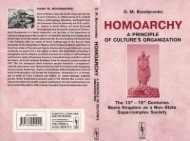L. Fituni, I. Abramova Resource Potential of Africa and Russia's ...
L. Fituni, I. Abramova Resource Potential of Africa and Russia's ...
L. Fituni, I. Abramova Resource Potential of Africa and Russia's ...
You also want an ePaper? Increase the reach of your titles
YUMPU automatically turns print PDFs into web optimized ePapers that Google loves.
upon the same ideology: the new roads, pipelines, communications<br />
facilities are being built not so much as to improve the internal territorial<br />
integrity <strong>of</strong> <strong>Africa</strong>n counties <strong>and</strong> bring the peripheries closer<br />
to the centers, but in order to allow the <strong>Africa</strong>n natural wealth to<br />
reach the sea ports or external borders.<br />
The European Commission, the European Investment Bank<br />
(EIB), <strong>and</strong> other European development financing institutions, in cooperation<br />
with <strong>Africa</strong>n national <strong>and</strong> regional authorities, continue to<br />
assess how to promote the most appropriate infrastructure, <strong>and</strong> related<br />
governance issues, that can contribute to the sustainable use <strong>of</strong><br />
the resources <strong>of</strong> these countries <strong>and</strong> facilitate raw materials supply,<br />
using respective sector dialogues to steer this process. From its part,<br />
the European Commission promised “to assess (a) the feasibility <strong>of</strong><br />
increasing lending (which may include grant-loan elements) to industry,<br />
including mining <strong>and</strong> refining projects <strong>and</strong> in particular postextractive<br />
industries <strong>and</strong> (b) investigate the possibility <strong>of</strong> promoting<br />
financial instruments that reduce risk for operators on the basis <strong>of</strong><br />
guarantees supported by EU, including by the European Development<br />
Fund. The existing EU-<strong>Africa</strong> Infrastructure Trust Fund could<br />
also assist <strong>Africa</strong>n countries in this task.” 25<br />
1.2. South Atlantic <strong>Resource</strong> Base in NATO’s Modernized<br />
Strategy<br />
After the Soviet Union disappeared from the global arena, the<br />
United States <strong>and</strong> its NATO allies gradually renewed the old strategy<br />
<strong>of</strong> strengthening their presence <strong>and</strong> activity in <strong>Africa</strong>. Unlike the<br />
old days <strong>of</strong> the bi-polar world, the renewed recognition <strong>of</strong> <strong>Africa</strong>’s<br />
growing strategic importance to U.S. interests was manifested<br />
openly. Since the main ideological <strong>and</strong> geostrategic rival had gone,<br />
there was no need for the US to camouflage the real reasons for the<br />
renewed interest by alleged concern about democracy <strong>and</strong> freedom<br />
in <strong>Africa</strong>. A more 19th century list <strong>of</strong> arguments was presented, such<br />
as the increasing importance <strong>of</strong> <strong>Africa</strong>’s natural resources, particularly<br />
energy resources, <strong>and</strong> mounting concern over violent extremist<br />
activities <strong>and</strong> other potential threats posed by uncontrolled spaces,<br />
33







